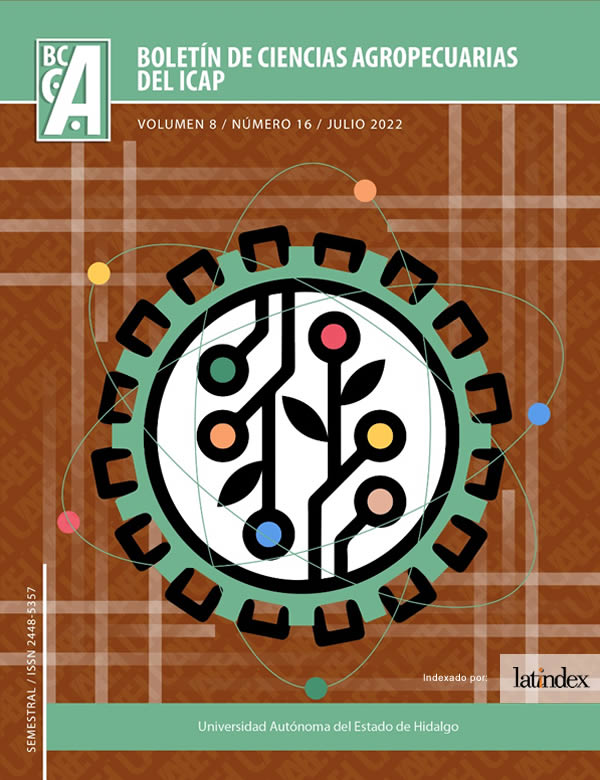Probiotics extracted from plant and animal sources
Abstract
Probiotics are microorganisms that, when administered in adequate amounts, exert a beneficial effect on the health of the host, helping to restore the intestinal microbiome, which provides benefits such as the synthesis of certain vitamins of group B, improves the bioavailability of nutrients, reduces LDL cholesterol in the blood, improves immune function and antimicrobial activity on pathogenic microorganisms. There are various plant sources where various probiotic microorganisms have been reported, such as Bacillus, which are obtained from stingless honey and moldy corn, yeasts obtained from certain cereals such as fura and altamura sourdough, lactic acid bacteria and bifidobacteria extracted from fermented vegetables from the East such as kimchi, cabbage, cucumber and pocai, and animal sources from which the use of LAB extracted from breast milk, from chickens free of pathogenic microorganisms and from buffalo milk have been reported.Mainly all microorganisms were isolated to evaluate resistance to antibiotics, at bile concentrations of 0.3%, acid concentrations with a pH of between 2-3, antimicrobial activity against strains of pathogenic bacteria such as Salmonella, Listeria, Escherichia coli, and Bacillus, in order to know if these microorganisms can be suitable as possible probiotics.
Downloads
References
Arroyo, F. A., & Gómez, J. S. Potencial probiótico de cepas de bacillus aisladas de miel y polen de tucuman, 2018. Obtenido de https://bdigital.uncu.edu.ar/objetos_digitales/13082/17-ciencia-tecnologa-e-innovacin-arroyo-florencia-untucumn.pdf
Morelli, L. In vitro assessment of probiotic bacteria: From survival to functionality. International Dairy Journal. 2007; 17(11): 1278-1283.
Lebaka, V. R., Wee, Y. J., Narala, V. R. & Joshi, V. K. Lebaka, Veeranjaneya Reddy, et al. "Development of new probiotic foods—a case study on probiotic juices." Therapeutic, probiotic, and unconventional foods. 2018: 55-78.
Zulkhairi Amin, F. A., Sabri, S., Ismail, M., Chan, K. W., Ismail, N., Mohd Esa, N., ... & Zawawi, N. Probiotic Properties of Bacillus Strains Isolated from Stingless Bee (Heterotrigona itama) Honey Collected across Malaysia. International Journal of Evironmental Research and Public Health. 2020:17(1): 278..
Chen, F., Zhu, L., & Qiu, H. Isolation and probiotic potential of Lactobacillus salivarius and Pediococcus pentosaceus in specific pathogen free chickens. Brazilian Journal of Poultry Science. 2017; 19: 325-332.
Salazara, B. C., & Montoya, O. I. Importancia de los probióticos y prebióticos en la salud humana. Vitae. 2003; 10(2): 20-26.
Gastroenterología, O. M. Probióticos y prebióticos. World Gastroenterology. 2011. Obtenido de https://www.worldgastroenterology.org/UserFiles/file/guidelines/probiotics-spanish-2011.pdf
Torno Carnicé, R. Probióticos. Concepto. An Pediat, 2006; 30-41.
Armachius, J., & Yousheng, W. Caracterización, beneficios para la salud y aplicaciones de probióticos de frutas y verduras. CyTA: Journal of food. 2019; 17(1): 770-780.
Bernal Castro, C. A., Díaz-Moreno, C., & Gutiérrez-Cortés, C. Probióticos y prebióticos en matrices de origen vegetal: Avances en el desarrollo de bebidas de frutas. Revista chilena de nutrición. 2017; 44(4): 383-392. https://dx.doi.org/10.4067/s0717 75182017000400383
Lee A, Cheng K-C, Liu J-R. Isolation and characterization of a Bacillus amyloliquefaciens strain with zearalenone removal ability and its probiotic potential. PLoS ONE. 2017; 12(8): e0182220. https://doi.org/10.1371/journal. pone.0182220 Editor: Petr Karlov
Lindegaard Pedersen, L., Owusu-Kwarteng, J., Thorsen, L., & Jespsern, L. Biodiversity and probiotic potential of yeasts isolated from Fura, a West African spontaneously fermented cereal. International Journal of Food Microbiology. 2012; 159: 144-151.
Perricone, M., Bevilacqua, A., Corbo, M. R., & Sinigaglia, M. Technological characterization and probiotic traits of yeasts isolated from Altamura sourdough to select promising microorganisms as functional starter cultures for cereal-based products. Food Microbiology. 2014; 38: 26-35.
Landa-Salgado, P., Caballero-Cervantes, Y., Ramírez-Bribiesca, E., Hernández-Anguiano, A. M., Ramírez-Hernández, L. M., Espinosa-Victoria, D., & Hernández-Sánchez, D. Aislamiento e identificación de bacterias ácido lácticas con potencial probiótico para becerros del altiplano mexicano. Revista mexicana de ciencias pecuarias. 2019; 10(1): 68-83.
Cao, Z., Pan, H., Tong, H., Gu, D., Li, S., Xu, Y., ... & Lin, Q. In vitro evaluation of probiotic potential of Pediococcus pentosaceus L1 isolated from paocai—a Chinese fermented vegetable. Annals of microbiology. 2016; 66(3): 963-971.
Lee, K. W., Shim, J. M., Park, S. K., Heo, H. J., Kim, H. J., Ham, K. S., & Kim, J. H. Isolation of lactic acid bacteria with probiotic potentials from kimchi, traditional Korean fermented vegetable. LWT-Food Science and Technology. 2016; 71: 130-137.
Zielińska, D., Rzepkowska, A., Radawska, A., & Zieliński, K. In vitro screening of selected probiotic properties of Lactobacillus strains isolated from traditional fermented cabbage and cucumber. Current microbiology. 2015; 70(2): 183-194.
Liu, W., Chen, M., Duo, L., Wang, J., Guo, S., Sun, H., ... & Zhang, H. Characterization of potentially probiotic lactic acid bacteria and bifidobacteria isolated from human colostrum. Journal of dairy science. 2020; 103(5): 4013-4025.
Melia, S., Yuherman, Y., Jaswandi, J., & Purwati, E. Selection of buffalo milk, lactic acid bacteria with probiotic potential. Asian J Pharm Clin Res. 2018; 11(6): 186-189.










